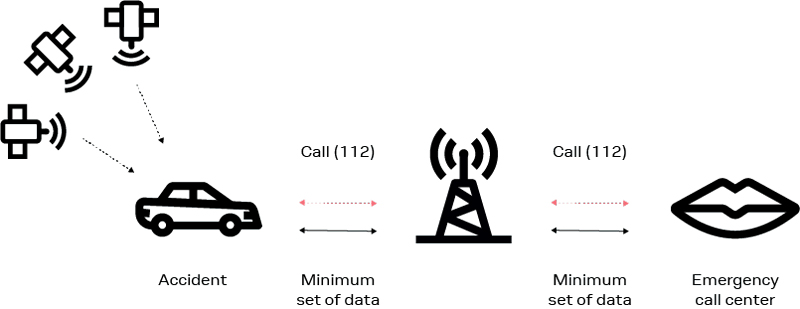eCall: How good would that be if your car could call for help?
In recent decades, the number of traffic fatalities has plummeted, thanks to an increasing number of safety features on board, from seat belts to airbags to new lane keeping assistance systems. But even in the European road network, the safest in the world, over 25,000 people lose their lives every year. In addition, another 135,000 people are seriously injured.
Every minute counts in a serious accident. Delays can make a difference to life and death. The worst situation is for those who are out of action in their vehicles and cannot reach their phone, especially if they happen to be on the countryside on a little-used road. How good would that be if instead the car could call for help?
The time gained would have enormous effects. Rescue teams could be up to 40% faster in urban areas and 50% faster in rural areas, because an emergency call is placed without delay and the location is clearly sent, the EU's Committee on the Internal Market and Consumer Protection. An estimated 2,500 lives could be saved, countless injuries could be supplied faster, and the cost to the public could be reduced by 20%.
This idea, which has been in development for a long time, became mandatory in April 2018 throughout Europe and Russia. Since then, all new cars and vans sold in these countries must be equipped with automated emergency call systems that can automatically make an emergency call after an airbag is deployed or manually via buttons integrated in the dashboard.
Save lives - with and without orders
In the event of an accident, these systems, called eCall in Europe and ERA-GLONASS in Russia , automatically set up a voice call to the appropriate emergency number. They send a packet of important information to the emergency services, including the position of the vehicle, whether the emergency call is now automatic or manual, the vehicle type, the direction of travel and, optionally, the number of passengers.
Given the apparent benefits of the service, many car manufacturers around the world have already implemented emergency services in their fleets without such a commitment. While all solutions currently on the market have the ultimate goal of saving lives, the lack of internationally agreed standards and differences in the legal environment of each region has led to a variety of approaches, all geared towards the same goal.
Take the example of the United States, where emergency services are typically offered as proprietary services. As in Europe, they are bundled with a minimum amount of data that helps speed up rescue operations. One important difference is that automatic dialling of E-911 (enhanced 911) is generally prohibited. As a result, incoming calls are typically checked by specialised call centres before they are forwarded to local emergency services, if necessary.
In China, the situation is very similar. There, normal voice calls go to a call centre, from where they are routed to emergency services when needed. Japan, on the other hand, is closer to a standardised solution in which a TCP / IP-based call is made in parallel with the voice call and a data packet is sent with corresponding data.
The data that will ultimately be transmitted to the emergency services will all serve the same purpose: giving the exact location of the accident, information on the make, model and colour of the car for quick identification and basic parameters of the accident (if the emergency call was caused by airbags deployed). The voice call is considered optional while the data packet may trigger emergency response. Talking to the passengers can bring additional information and reassuring them that help is on the way.

Connected by law
Regardless of the details of their implementation, eCall systems installed in vehicles build on the same basis: a GNSS receiver that determines the exact location of the vehicle and a cellular module with an in-band modem or TCP / IP data mode, with which data can be sent accompanying to a voice call. An example of this is the u-blox SARA-G3 series of modems.
And given that the Russian ERA GLONASS and European eCall service are required by law, all new vehicles rolling off the line to be sold in Europe are networked vehicles. And not only that, the infrastructure that enables these services forms the backbone of new, high-quality services, such as bCall, for a breakdown service. Also conceivable would be cCall for concierge services, which offers selected vehicle owners all kinds of services from valet parking to opera tickets.
For more information on implementing eCall, ERA-GLONASS and other automotive emergency call systems, contact a u-blox.
Guest blog written by, Stefan Gudmundsson, Director Product Strategy, u-blox.
Courtesy of u-blox.



